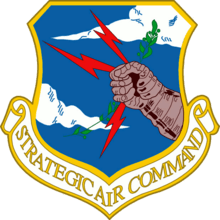RAF Lakenheath
Royal Air Force Lakenheath or RAF Lakenheath (IATA: LKZ, ICAO: EGUL) is a Royal Air Force station near the village of Lakenheath in Suffolk, England, UK, 4.7 miles (7.6 km) north-east of Mildenhall and 8.3 miles (13.4 km) west of Thetford. The base also sits close to Brandon.
| RAF Lakenheath | |||||||
|---|---|---|---|---|---|---|---|
| Near Eriswell, Suffolk in England | |||||||
.jpg) Boeing F-15E Strike Eagles of the 48th Fighter Wing taxiing at Lakenheath. | |||||||
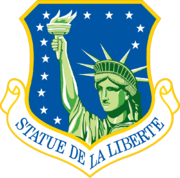 | |||||||
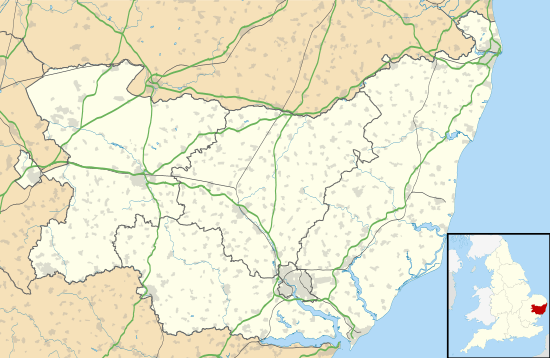 RAF Lakenheath Shown within Suffolk | |||||||
| Coordinates | 52°24′30″N 000°33′24″E | ||||||
| Type | RAF station (US Visiting Forces) | ||||||
| Code | LN | ||||||
| Area | 727 hectares[1] | ||||||
| Site information | |||||||
| Owner | Ministry of Defence | ||||||
| Operator | United States Air Force | ||||||
| Controlled by | United States Air Forces in Europe - Air Forces Africa (USAFE-AFAFRICA) | ||||||
| Condition | Operational | ||||||
| Website | www | ||||||
| Site history | |||||||
| Built | 1940 | ||||||
| In use | 1941 – 1948 (Royal Air Force) 1948 – present (US Air Force) | ||||||
| Garrison information | |||||||
| Current commander | Colonel William L. Marshall | ||||||
| Garrison | 48th Fighter Wing | ||||||
| Occupants |
| ||||||
| Airfield information | |||||||
| Identifiers | IATA: LKZ, ICAO: EGUL, WMO: 03583 | ||||||
| Elevation | 10 metres (33 ft) AMSL | ||||||
| |||||||
Despite being an RAF station, Lakenheath currently only hosts United States Air Force units and personnel. The host wing is the 48th Fighter Wing (48 FW), also known as the Liberty Wing, assigned to United States Air Forces in Europe - Air Forces Africa (USAFE-AFAFRICA).
History
First World War
The first use of Lakenheath Warren as a Royal Flying Corps airfield was during the First World War, when the area was made into a bombing and ground-attack range for aircraft flying from elsewhere in the area. It appears to have been little used, and was abandoned when peace came in 1918.
Second World War (1940–1945)
Royal Air Force use
In 1940, the Air Ministry selected Lakenheath as an alternative for nearby RAF Mildenhall and used it as a decoy airfield. False lights, runways and aircraft diverted Luftwaffe attacks from Mildenhall.
Surfaced runways were constructed in 1941, with the main runway (04/22) being 2,000 yards, and the subsidiaries at 1,300 yards (12/30) and 1,400 yards (16/34). Another 100 yards was added to runway 16/34. Hardstands for thirty-six aircraft were built, along with two T-2 and a B-1 hangar. One T-2 was on the technical site, the other hangars to the east across the Mildenhall-Brandon road (A1065) were reached by taxiways.
Lakenheath was used by RAF flying units on detachment late in 1941. The station soon functioned as a Mildenhall satellite with Short Stirling bombers of No. 149 Squadron dispersed from the parent airfield as conditions allowed. The squadron exchanged its Vickers Wellingtons for Stirlings late in November 1941. After becoming fully operational with its new aircraft, the squadron moved into Lakenheath on 6 April 1942 and remained until mid 1944 when the squadron moved to RAF Methwold in Norfolk.[2]
Taking part in more than 350 operations, more than half mine-laying, No. 149 Squadron had one of the lowest percentage loss rates of all Stirling squadrons. One Stirling pilot, Flight Sergeant Rawdon Middleton, was posthumously awarded the Victoria Cross for valour on the night of 28–29 November 1942, when despite serious face wounds and loss of blood from shell-fire during a raid on the Fiat works at Turin in Italy, he brought the damaged aircraft back towards southern England. With fuel nearly exhausted his crew were ordered to bail out.[3] Middleton was killed when the Stirling, BF372 OJ-H, crashed into the English Channel.
In early 1943, three T-2 hangars were erected on the north side of the airfield for glider storage, forty Horsa Gliders being dispersed at Lakenheath during that year.
On 21 June 1943, No. 199 Squadron was established as a second Stirling squadron.[4] Commencing operations on 31 July, it laid mines during the winter of 1943–44. At the end of April 1944, after sixty-eight operations, the squadron transferred to No. 100 Group for bomber support, moving to RAF North Creake in Norfolk on 1 May 1944.[5]
No. 149 Squadron ended its association with RAF Lakenheath the same month, taking its Stirlings to RAF Methwold.[2] Between them, the two squadrons lost 116 Stirling bombers in combat while flying from Lakenheath.
The reason for the departure of the two bomber squadrons was Lakenheath's selection for upgrading to a Very Heavy Bomber airfield. Lakenheath was one of three RAF airfields being prepared to receive United States Army Air Forces Boeing B-29 Superfortresses, which were tentatively planned to replace some of Eighth Air Force's Third Air Division Consolidated B-24 Liberator groups in the spring of 1945.
The work entailed removal of the existing runways and laying new ones comprising 12 inches of high-grade concrete. The main runway (07/25) was 3,000 yards long; the subsidiaries, 01/19 and 14/32, both 2,000 yards; all three being 100 yards wide. Part of the A1065 road between Brandon and Mildenhall was closed, and a new section built further to the east on the Warren. During the peak period of construction, over 1,000 men were working on the site; yet instead of the 12 months planned, it took 18 months for the ground work alone and 2 1⁄2 years before Lakenheath's transformation was complete. The cost was nearly £2 million.
By the time construction ended the war with Germany was over and RAF Lakenheath was put on a care and maintenance status.
Cold War (1946–1990)
Cold War tensions with the Soviet Union in Europe began as early as 1946. In November, President Harry S. Truman ordered Strategic Air Command (SAC) B-29 bombers to RAF Burtonwood in Lancashire, and from there to various bases in West Germany as a "training deployment". In May 1947, additional B-29s were sent to the UK and Germany to keep up the presence of a training program. These deployments were only a pretense, as the true aim of these B-29s was to have a strategic air force permanently stationed in Europe.
In April 1947, RAF Bomber Command returned to Lakenheath and had the runways repaired, resurfaced, and readied for operations by May 1948.
Strategic Air Command

In response to the threat by the Soviet Union, by the 1948 Berlin blockade, President Truman decided to realign United States Air Force Europe (USAFE) into a permanent combat-capable force. In July, B-29 Superfortresses of the SAC 2nd Bombardment Group were deployed to Lakenheath for a 90-day temporary deployment.
On 27 November 1948, operational control of RAF Lakenheath was transferred from the Royal Air Force to USAFE. The first USAFE host unit at Lakenheath was the 7504th Base Completion Squadron, being activated on that date. The squadron was elevated to an Air Base Group (ABG) on 28 January 1950, and to a Wing (ABW) on 26 September 1950.
Control of Lakenheath was allocated to the Third Air Force at RAF South Ruislip, which had command of SAC B-29 operations in England. The Third Air Force was subsequently placed directly under USAF orders, with SAC establishing the 7th Air Division Headquarters at RAF Mildenhall. The collocation of the two headquarters within the United Kingdom allowed HQ USAFE to discharge its responsibilities in England, while at the same time allowing SAC to continue in its deterrent role while retaining operational control over flying activities at Lakenheath.
By 1950, Lakenheath was one of three main operating bases for the SAC in the UK, the others being RAF Marham and RAF Sculthorpe both in Norfolk. A succession of bombardment squadrons and wings, thirty-three in all, rotated through Lakenheath, the B-29s giving way to the improved Boeing B-50 Superfortresses and subsequently, in June 1954, Boeing B-47 Stratojets.
On 1 May 1951, Lakenheath was transferred from USAFE to SAC, and placed under the 3909th Air Base Group. By 1952, a high security perimeter fencing was erected. The 3909th moved to RAF Greenham Common in Berkshire during 1954, and was replaced by the 3910th Air Base Group.
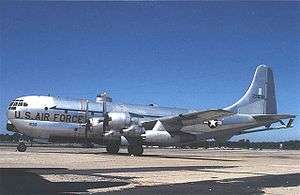
Known SAC units which deployed to RAF Lakenheath on temporary duty (TDY) were:
- 830th Bombardment Squadron (1 June 1949 – 21 August 1949) (B-50D)
(TDY from the 509th Composite Group, Walker AFB, New Mexico) - 65th Bombardment Squadron (15 August 1949 – 15 November 1949) (B-50D)
(TDY From the 43d Bombardment Wing, Davis-Monthan AFB, Arizona) - 33d Bombardment Squadron (20 November 1949 – 18 February 1950) (B-29)
(TDY From the 22d Bombardment Wing, March AFB, California) - 96th Bombardment Squadron (22 February 1950 – 12 May 1950) (B-50D)
(TDY From the 2d Bombardment Wing, Hunter AFB, Georgia) - 301st Bombardment Wing (28 June 1950 – 28 November 1950) (B-29)
(TDY From Barksdale AFB, Louisiana) - 97th Bombardment Wing (15 March 1952 – 1 April 1952) (B-50D, KC-97)
(TDY From Biggs AFB, Texas) - 19th Bombardment Squadron (6 September 1951 – 13 December 1951) (B-29)
(TDY From the 22d Bombardment Wing, March AFB, California)
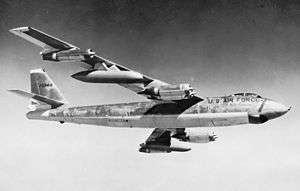
The increasing tension of the Cold War lead to a re-evaluation of these deployments, and by 1953 SAC bombers began to move its heavy bomb groups further west, behind RAF fighter forces, to RAF Brize Norton, RAF Greenham Common, RAF Upper Heyford and RAF Fairford, while its shorter-range B-47 were sent to East Anglia.
- 43d Air Refueling Squadron (21 March 1953 – 5 June 1953) (KC-97)
(TDY From the 43d Bombardment Wing, Davis-Monthan AFB, Arizona) - 321st Bombardment Wing (9 December 1954 – 9 March 1955) (B-47, KC-97)
(TDY From Pinecastle AFB, Florida) - 40th Bombardment Wing (9 June 1955 – 9 September 1955) (B-47, KC-97)
(TDY From Schilling AFB, Kansas) - 340th Bombardment Wing (14 September 1955 – 3 November 1955) (B-47, KC-97)
(TDY From Whiteman AFB, Missouri) - 98th Bombardment Wing (12 November 1955 – 28 January 1956) (B-47, KC-97)
(TDY From Lincoln AFB, Nebraska) - Lakenheath Task Force (Provisional) (1 May 1955 – UNK) (RB/ERB-47H) (Electronic Reconnaissance and Countermeasures)
(TDY From 55th Strategic Reconnaissance Wing, Forbes AFB, Kansas) - 509th Air Refueling Squadron (26 January 1956 – 30 April 1956) (KC-97)
(TDY From Walker AFB, New Mexico) - 307th Bombardment Wing (11 July 1956 – 5 October 1956) (B-47, KC-97)
(TDY From Lincoln AFB, Nebraska)
Many SAC Squadrons had aircraft at Lakenheath on a transitory basis without any recorded deployment to the base. For example, in January 1951, a detachment of Convair RB-36D Peacemaker intercontinental bombers from the 5th Strategic Reconnaissance Wing at Travis AFB, California arrived for a few days, and various tanker and transport aircraft also made periodic appearances at the base. Several of the temporary detachments included in-flight refuelling tanker aircraft.
On 30 April 1956, two Lockheed U-2s were airlifted to Lakenheath to form CIA Detachment A. The first flight of the U-2 was on 21 May. The Central Intelligence Agency unit did not remain long, moving to Wiesbaden Air Base, West Germany[6] on 15 June.
A near nuclear accident occurred on 27 July 1956 when a B-47 bomber crashed into a storage igloo at Lakenheath containing three Mark-6 nuclear weapons while on a routine training mission. Although the bombs involved in the accident did not have their fissile cores installed, each of them carried about 8,000 pounds of high explosives as part of their trigger mechanism. The crash and ensuing fire did not ignite the high explosives and no detonation occurred. The damaged weapons and components were later returned to the Atomic Energy Commission. The B-47 involved in the accident, which killed four crewmen, was part of the 307th Bombardment Wing.[7]
On 10 October 1956, a United States Navy Douglas R6D-1 Liftmaster disappeared over the Atlantic Ocean after departure from RAF Lakenheath for a flight to Lajes Field in the Azores. The aircraft was on a Military Air Transport Service flight carrying 50 members of the 307th Bombardment Wing, on their way home to the United States after a temporary duty assignment and a US Navy crew of nine. All 59 personnel on board were lost.[8][9][10][11]
48th Tactical Fighter Wing
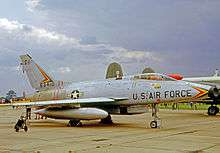
Following French president Charles de Gaulle's insistence in 1959 that all non-French nuclear-capable forces should be withdrawn from his country, the USAF began a redeployment of its North American F-100-equipped units from France. The 48th TFW left its base at Chaumont-Semoutiers Air Base, France on 15 January 1960, its aircraft arriving at Lakenheath that afternoon. When the first F-100D touched down on Lakenheath's runway, the landing symbolised a return for the Statue of Liberty Wing. Almost 16 years had passed since the Second World War Ninth Air Force 48th Fighter Group's arrival at RAF Ibsley, England, for the D-Day invasion.
In conjunction with this transfer, control of Lakenheath was transferred from Strategic Air Command back to USAFE. As SAC elements began their departure, the 3910th Air Base Group began its transition of handing Lakenheath's facilities and real estate over to the 48th's Combat Support Group elements.
The tactical components of the 48th TFW upon arrival at Lakenheath were:
- 492d Tactical Fighter Squadron (LR, blue colours)
- 493d Tactical Fighter Squadron (LS, yellow colours)
- 494th Tactical Fighter Squadron (LT, red colours)
The squadron markings consisted of alternating stripes across the tailfin in squadron colours, with a shadowed "V" shaped chevron on the nose. Starting in March 1970, squadron tail codes (shown above) were added when the aircraft went from a natural finish to a Southeast Asian camouflage motif.
The period between 1972 and 1977 can be described as a five-year aircraft conversion. Beginning in late 1971, the 48th TFW started its conversion to the McDonnell Douglas F-4D Phantom II, with the aircraft being transferred from the 81st TFW at RAF Bentwaters in Suffolk. The conversion to the F-4D took several years, with the last F-100 departing in August 1974. With the arrival of the Phantoms, the F-4s adopted a common tail code of "LK". This tail code lasted only a few months as in July and August 1972 the 48th TFW further recoded to "LN". The F-4D carried squadron identifying fin cap colours of blue, yellow and red (492d, 493d, 494th respectively).
The F-4's service with the 48th TFW was short, as operation "Ready Switch" transferred the F-4D assets to the 474th TFW at Nellis AFB, Nevada. The 474th sent their General Dynamics F-111. As to the 366th TFW at Mountain Home AFB, Idaho, and the 366th sent their F-111Fs to Lakenheath in early 1977.
A fourth fighter squadron, the 495th Tactical Fighter Squadron was activated with the 48th TFW on 1 April 1977, with a squadron tail colour of green. This was 33 years to the day since the squadron's inactivation. The 495th's mission of functioning as a replacement training unit for the other three fighter squadrons. This made the 495th and the 48th TFW unique, as the only WSO (Weapons System Operator) training unit for USAFE.
F-111s from the 48th TFW participated in 1986 United States bombing of Libya in 1986. This bombing of Libya prompted the mock-acronym, 'Lakenheath Is Bombing Your Ass'. During the operation one F-111 from Lakenheath was shot down by Libyan forces and the two crew members were killed. The Libyan government eventually returned one of the bodies.
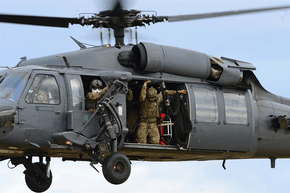
Post Cold War (1991 – present)
Lakenheath received its first McDonnell Douglas F-15E Strike Eagles in 1992. With the departure of the F-111s, the 495th FS was inactivated on 13 December 1991. On 18 December 1992, the last F-111 departed the base. Along with its departure, the 493d FS was also inactivated.
With the pending closure of Bitburg Air Base in Germany on 25 February 1994, it was decided to reactivate the 493d as an F-15C/D squadron. Aircraft were transferred from the 33d Fighter Wing at Eglin AFB, Florida, and the 493d was reactivated on 1 January. The 493d's arrival meant that the 48th became the largest F-15E/F-15C composite unit in the U.S. Air Force.
In 2003, the 48th FW received the first of ten new F-15Es. The aircraft were part of the final batch of F-15s expected to be ordered by the Air Force.
On 2 March 2011, members of the 48th Security Forces Squadron were involved in a shooting at Frankfurt Airport in Germany. The members were on a bus bound for Ramstein Air Base in Germany when they were attacked by a lone gunman.[12]
On 22 March 2011, F-15E 91-0304 crash-landed and was destroyed in eastern Libya after reportedly suffering from a mechanical failure. Both crewmen ejected and were safely recovered.[13] On 7 January 2014, a Sikorsky HH-60 Pave Hawk from the base crashed following a bird strike while on a low-level training exercise with another helicopter (also a Pave Hawk), into the Cley Marshes near Cley next the Sea on the nearby North Norfolk coast. All four occupants died in the crash.[14][15]
On 8 October 2014, F-15D 86-0182 belonging to the 493d Fighter Squadron crashed during a training flight in a field outside Spalding, Lincolnshire. The pilot successfully ejected and was shortly recovered back to Lakenheath on board a Pave Hawk.[16]
A US Marine Corps Boeing F/A-18 Hornet of VMFA-232 "Red Devils" from MCAS. Miramar, California, crashed after taking off from RAF Lakenheath on 21 October 2015. The pilot, Major Taj "Cabbie" Sareen (34), did not survive.[17]
On 15 June 2020, an F-15C belonging to the 493d Fighter Squadron crashed during a training flight in the North Sea, 74 nautical miles east of Scarborough at about 54°21′00″N 001°40′00″E. The body of pilot 1st Lt. Kenneth Allen has been found deceased.[18] .[19]
Role and operations
The 48th Fighter Wing at RAF Lakenheath is the Statue of Liberty Wing, the only USAF wing with both a number and a name. Since activation at Chaumont-Semoutiers AB, France, on 10 July 1952, Liberty Wing has been one of the premier fighter wings of the United States Air Forces in Europe, spending over 50 years as part of USAFE. The 48 FW has nearly 5,700 active-duty military members, 2,000 British and U.S. civilians, and includes a Geographically Separate Unit (GSU) at nearby RAF Feltwell.
Tactical squadrons of the 48th Operations Group are:
- 492nd Fighter Squadron (F-15E)
- 493rd Fighter Squadron (F-15C/D)
- 494th Fighter Squadron (F-15E)
Aircraft of the 48th FW carry the tail code "LN".
In addition to supporting three combat-ready squadrons of F-15E Strike Eagle and F-15C Eagle fighter aircraft, the Liberty Wing housed the 56th Rescue Squadron's HH-60G Combat Search and Rescue helicopters. The 56th and 57th Rescue Squadrons re-located to Aviano Air Base in 2018.[20]
RAF Lakenheath and its sister base RAF Mildenhall are the two main U.S. Air Force bases in United Kingdom, and 48th Fighter Wing is the only U.S. Air Force F-15 fighter wing in U.K. and also in Europe.
48th Fighter Wing
 48th Fighter Wing
48th Fighter Wing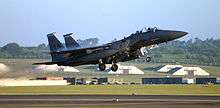 A 492d Fighter Squadron F-15E Eagle from Lakenheath lifts off from the airfield's runway
A 492d Fighter Squadron F-15E Eagle from Lakenheath lifts off from the airfield's runway- The F-100 is displayed on a permanent stand. It was the second aircraft to represent the Liberty Wing. It flew for the 48th Fighter Wing between 1956 and 1972 before it was replaced by the F-4 Phantom.
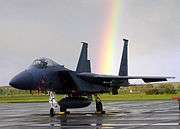 F-15C Eagle aircraft from the 493rd Fighter Squadron, 48th Fighter Wing, parked on the tarmac at RAF Lakenheath
F-15C Eagle aircraft from the 493rd Fighter Squadron, 48th Fighter Wing, parked on the tarmac at RAF Lakenheath
Based units
Flying and notable non-flying units based at RAF Lakenheath.[21]
United States Air Force
United States Air Forces in Europe - Air Forces Africa (USAFE-AFAFRICA)
- 48th Fighter Wing
- 48th Operations Group
- 492d Fighter Squadron – F-15E Strike Eagle
- 493d Fighter Squadron – F-15C/D Eagle
- 494th Fighter Squadron – F-15E Strike Eagle
- 48th Operations Support Squadron
- 48th Maintenance Group
- 48th Aircraft Maintenance Squadron
- 748th Aircraft Maintenance Squadron
- 48th Component Maintenance Squadron
- 48th Equipment Maintenance Squadron
- 48th Maintenance Operations Squadron
- 48th Munitions Squadron
- 48th Medical Group
- 48th Dental Squadron
- 48th Inpatient Operations Squadron
- 48th Medical Operations Squadron
- 48th Medical Support Squadron
- 48th Surgical Operations Squadron
- 48th Mission Support Group
- 48th Civil Engineer Squadron
- 48th Communications Squadron
- 48th Contracting Squadron
- 48th Force Support Squadron
- 48th Logistics Readiness Squadron
- 48th Security Forces Squadron
- 48th Operations Group
Future
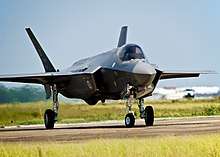
F-35A Lightning II
In January 2015, the US Department of Defense announced that from 2020, Lakenheath would become home to 54 of the US Air Force's Lockheed Martin F-35A Lightning II multi-role fighters.[22][23] The aircraft would be split between two squadrons and there would be an increase of 1,200 military personnel and between 60–100 civilian workers at the station. The F-35 would operate alongside the two existing F-15E squadrons based at Lakenheath.[24] By November 2018, the number of craft had been revised to 48 and their arrival date as late 2021.[25]
F-35 Infrastructure
To accommodate the new aircraft a F-35 Campus is to be constructed on the south side of the airfield.[26]
Projects
The main new operational buildings being developed as part of the F-35 project are as follows.[27]
- Two six-bay maintenance hangars – Space for service, maintenance, storage, and staff support facilities (to be known as Hangars 4-1 and 4-2).
- Hangar 6 (Consolidated Parts Store) – Single-storey extension to the southern side of Hangar 6, including offices and warehouses and the storage of aircraft equipment and parts.
- Dual Squadron Operations/Aircraft Maintenance Unit – A three-storey building to provide combined facilities for two squadrons comprising Squadron Operations and Aircraft Maintenance Unit (AMU) facilities, including mission planning, administration space in the operations section and offices to manage the maintenance of aircraft and storage space.
- Corrosion control and wash rack facility – Comprising single-storey hangar to maintain aircraft including a paint and sanding booth and wash rack.
- Flight simulator facility – Comprising a single-storey building to accommodate six F-35A flight simulators, administration, records, classrooms, brief/debrief rooms, and storage space.
- A Field Training Detachment Facility, comprising A three-storey building to provide F-35A training programme to maintain the aircraft, incorporating classrooms and administration rooms. Field Training Detachment Facility – A three-storey building to provide F-35A maintenance, including classrooms and administration rooms.
- Aircraft Generation Equipment (AGE) Facilities – A single storey building extension and new covered storage associated with an existing building used for maintenance and storage of AGE related to the F-35A.
- Fuel System Maintenance Dock – A single storey hangar with fuel system maintenance dock to support the operation of the F-35A.
- Munitions Maintenance Facility – A single storey building extension and new covered storage to an existing building for the maintenance of munitions used by the F-35A.
- Residential accommodation – A three or four-storey dormitory for up to 144 beds to accommodate the increase in station personnel.
- Flight-line Dining Facility
- Munitions Storage Administration Maintenance building
- Hospital – Replacement medical facility up to four storeys to provide inpatient services, outpatient and speciality care clinics, ancillary services, support and medical administrative functions.
- High school – A three or four-storey building to house approximately 560 students.
The airfield operational surfaces would also be expanded as follows.[28]
- Charlie Apron, currently used by F-15's will be redeveloped and extended to allow the parking of up to forty-two F-35A aircraft in dual-occupancy shelters constructed from a light weight, canopy structure with open sides. The total area of Charlie Apron once extended will be approximately 78,392 square metres, combining the retained area of 58,780 square metres with the new area of 19,612 square metres. It will be connected to Maintenance Hangars 4-1 and 4-2 and the Squadron Operations/AMU building.
- Alpha-Bravo Apron will be extended to accommodate existing F-15 aircraft currently using Charlie Apron. The total area of Alpha-Bravo Apron once extended will be approximately 54,179 square metres, combining the retained area of 39,750 square metres with the new area of 14,429 square metres. Up to thirty-eight F-15 aircraft will be capable of being accommodated on the open apron which would not feature any shelters.
Infrastructure delivery
Investment of $148.4 million (£116.7M) for the delivery of F-35A infrastructure at Lakenheath was authorised by the US administration in August 2018.[29]
In November 2018, the Defence Infrastructure Organisation awarded a £160M contract for infrastructure work to a joint venture between Kier Group and VolkerFitzpatrick.[30]
To make way for the F-35 Campus, demolition of the first of eighteen buildings began in March 2019.[31] The work on Alpha-Bravo Apron was completed in August 2020, allowing F-15E Strike Eagle operations of the 492nd and 494th Fighter Squadrons to be consolidated on one ramp.[32]
Heritage
Gate Guardian
RAF Lakenheath's gate guardian is North American F-100D Super Sabre, serial number '54-2269'. The aircraft was originally delivered to the French Air Force. On return it was moved to the "Wings of Liberty Memorial Park" at RAF Lakenheath. Firstly it was painted as '55-4048', latterly as '56-3319'.[33]
Protests
Since the Base's founding, Lakenheath has been targeted by numerous peace protests from groups such as Stop the war coalition and the Campaign for Nuclear Disarmament.
Pershing
Lakenheath was one of the proposed sites of the NATO Pershing II Missile System. The deployment of the Missile system sparked protests all over Western Europe, and RAF Lakenheath was one of the most prominent military sites. The radical historian E.P. Thompson wrote in a pamphlet that basing the system at RAF Lakeneath directly endangered the lives of those in the nearby city of Cambridge:
"...Lakenheath is, by crow or cruise, just over twenty miles from Cambridge. It is possible that Cambridge but less probable that Oxford will fall outside the CEP. Within the CEP we must suppose some fifteen or twenty detonations at least on the scale of Hiroshima, without taking into account any possible detonations, release of radio-active materials, etc., if the strike should succeed in finding out the cruise missiles at which it was aimed." [34]
A semi-permanent 'peace camp' was set up outside RAF Lakenheath.[35] In 1985, the future Archbishop of Canterbury Rowan Williams was arrested for singing Psalms at a CND protest at Lakeneath.[36] [37]
Iraq war
The 2003 Iraq War sparked a new wave of peace protests. In one incident, 9 protestors gained access to the base by cutting through its perimeter fence.The protestors rode bicycles along the main runway, before chaining themselves together. [38]
Activists later established a 'peace camp' outside RAF Lakenheath to draw attention to the base.[39]
See also
- List of Royal Air Force stations
- Strategic Air Command in the United Kingdom
- United States Air Force in the United Kingdom
- United States Air Forces in Europe - Air Forces Africa
References
Citations
![]()
![]()
- "Defence Estates Development Plan (DEDP) 2009 – Annex A" (PDF). GOV.UK. Ministry of Defence. 3 July 2009. p. 18. Retrieved 27 January 2019.
- Jefford 1988, p. 62.
- Bowyer 1979, p. 137.
- Jefford 1988, p. 67.
- Bowyer 1979, p. 138.
- Powers, Francis (1960). Operation Overflight: A Memoir of the U-2 Incident. Potomac Books, Inc. p. 23,29. ISBN 9781574884227.
- "Cable to Commander-in-Chief Strategic Air Command Gen Curtis LeMay". U.S. Department of Defense. 27 July 1956. Archived from the original on 19 May 2000. Retrieved 5 July 2006.
- Ranter, Harro. "ASN Aircraft accident Douglas R6D-1 (DC-6) 131588 Land's End, UK". aviation-safety.net.
- "US Navy and US Marine Corps BuNos—Third Series (130265 to 135773)". www.joebaugher.com.
- "Chronological History of Naval Air Transprt". www.vrc-50.org.
- Grossnick, Roy A., United States Naval Aviation 1910–1995, Washington, D.C.: Naval Historical Center, undated ISBN 0-945274-34-3, p. 214, claims the date was 11 October 1956.
- "Two U.S. airmen killed in German airport shooting". CNN. 3 March 2011.
- "US F-15 Eagle crash lands in Libya". BBC News. 22 March 2011.
- "Helicopter crash in Cley". Norfolk Constabulary. 7 January 2014. Archived from the original on 8 January 2014.
- "Geese caused fatal USAF helicopter crash in Cley, report says". BBC. 9 July 2014.
- "Safety fears after US jet crash". 9 October 2014 – via www.bbc.co.uk.
- "US Marine Corps pilot killed in F-18 jet crash in Cambridgeshire Fens". BBC Online. 21 October 2015. Retrieved 21 October 2015.
- Sandalls, Katy. "RAF Lakenheath airman who died following North Sea crash named". East Anglian Daily Times.
- "RAF Lakenheath: US fighter jet crashes into North Sea". BBC Online. 15 June 2020. Retrieved 15 June 2020.
- "Units". Royal Air Force Lakenheath. Retrieved 27 January 2019.
- Richmond, Tech. Sgt. Jake (8 January 2015). "Air Force F-35 Squadrons Slated for RAF Lakenheath Basing". US Department of Defense. Retrieved 20 March 2019.
- "US announces first F-35 in Europe to be based in the UK". GOV.UK. Ministry of Defence. 8 January 2015. Retrieved 20 March 2019.
- Howard, William (9 January 2017). "New facilities planned for F-35s at RAF Lakenheath". Stars and Stripes. Retrieved 20 March 2019.
- "Inside DIO – Proud partnership: working together to bring US F-35s to RAF Lakenheath". GOV.UK. Ministry of Defence and Defence Infrastructure Organisation. 19 November 2018. Retrieved 21 March 2019.
- Murphy, Rebecca (23 December 2017). "An exciting era as RAF Lakenheath prepares for the arrival of the F-35A Lightning". Thetford and Brandon Times. Retrieved 20 March 2019.
- Le Brecht 2018, pp. 5–8.
- Le Brecht 2018, p. 9.
- "RAF Lakenheath Gets $150 Million of Investment For F-35A". Forces Network. 16 August 2018. Retrieved 20 March 2019.
- "MOD awards £160m contract to prepare RAF Lakenheath for US F-35s". GOV.UK. Ministry of Defence. 19 November 2018. Retrieved 21 March 2019.
- "Demolition work begins at RAF Lakenheath". GOV.UK. Ministry of Defence and Defence Infrastructure Organisation. 19 March 2019. Retrieved 21 March 2019.
- Smith, Airman 1st Class Rhonda (14 August 2020). "Strike Eagles make room for F-35A arrival". Royal Air Force Lakenheath. US Air Force. Retrieved 16 August 2020.
- "Aircraft Data 54-2269, North American F-100D Super Sabre C/N 223-149". Airport-Data.com. Retrieved 1 February 2018.
- "Karthy Nair, progressive educator who always made herself heard". Islington Tribune.
- "Williams". Magdalene College.
- "Rowan Williams: God's boxer". the Guardian. 8 July 2011.
- "Arrests made after air base break-in". East Anglian Daily Times.
- "Activists gather at RAF Lakenheath to protest nukes". Stars and Stripes.
Bibliography
- Bowyer, J.F. Action Stations: Wartime military airfields of East Anglia 1939–1945 v. 1. Cambridge, Cambridgeshire, Patrick Stephens Ltd, 1979. ISBN 0-85059-335-2.
- Jefford, C G (1988). RAF Squadrons. A comprehensive record of the movement and equipment of all RAF squadrons and their antecedents since 1912. Shrewsbury: Airlife. ISBN 1-85310-053-6.
- Maurer, Maurer. Air Force Combat Units of World War II. Washington, DC: U.S. Government Printing Office 1961 (republished 1983, Office of Air Force History, ISBN 0-912799-02-1).
- Ravenstein, Charles A. Air Force Combat Wings Lineage and Honors Histories 1947–1977. Maxwell Air Force Base, Alabama: Office of Air Force History 1984. ISBN 0-912799-12-9.
- Fletcher, Harry R. (1989) Air Force Bases Volume II, Active Air Force Bases outside the United States of America on 17 September 1982. Maxwell AFB, Alabama: Office of Air Force History. ISBN 0-912799-53-6
- Rogers, Brian (2005). United States Air Force Unit Designations Since 1978. Hinkley, England: Midland Publications. ISBN 1-85780-197-0.
- Joe Baugher's Encyclopedia of American Aircraft
- USAAS-USAAC-USAAF-USAF Aircraft Serial Numbers—1908 to Present
- Strategic-Air-Command.com
- Le Brecht, H (19 February 2018). RAF Lakenheath Proposed Development – Environmental Impact Assessment (EIA) Screening Report (PDF). Mott MacDonald, Jacobs and the Defence Infrastructure Organisation.

.png)
